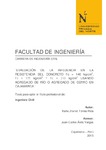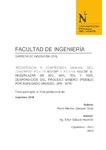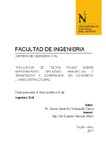Mostrar el registro sencillo del ítem
Evaluación de la influencia en la resistencia del concreto f’c = 140 kg/cm2, f’c = 175 kg/cm2 y f’c = 210 kg/cm2 usando agregado de río o agregado de cerro en Cajamarca
| dc.contributor.advisor | Ávila Vargas, Juan Carlos | |
| dc.contributor.author | Torres Ríos, Karla Jhanet | |
| dc.date.accessioned | 2017-02-01T23:33:17Z | |
| dc.date.available | 2017-02-01T23:33:17Z | |
| dc.date.issued | 2015-06-01 | |
| dc.identifier.citation | Torres, K. J. (2015). Evaluación de la influencia en la resistencia del concreto f’c = 140 kg/cm2, f’c = 175 kg/cm2 y f’c = 210 kg/cm2 usando agregado de río o agregado de cerro en Cajamarca (Tesis de licenciatura). Repositorio de la Universidad Privada del Norte. Recuperado de http://hdl.handle.net/11537/9603 | es_PE |
| dc.identifier.other | 620.136 TORR 2015 | es_PE |
| dc.identifier.uri | https://hdl.handle.net/11537/9603 | |
| dc.description.abstract | RESUMEN En el presente estudio se buscó medir la influencia en la resistencia del concreto al reemplazar en la misma cantidad del agregado de río (Cantera Chávez, río Mashcón) por el agregado de cerro (Cantera Don Lucho I, cerro El Guitarrero), para diferentes resistencias de uso común en Cajamarca, para lo cual se realizaron 144 tandas de concreto y 432 probetas cilíndricas. Para conocer el comportamiento de los agregados se evaluaron sus características físicas, mecánicas y químicas del agregado fino de río, agregado grueso de río y hormigón de cerro de acuerdo a ASTM C 33 o NTP 400.037. Se realizó el diseño de mezcla para f’c = 140 kg/cm2, f’c = 175 kg/cm2 y f’c = 210 kg/cm2 usando las características del agregado de río según método del comité 211 del ACI y método del módulo de finura de la combinación de agregados, las probetas se moldearon según el diseño del método del comité 211 del ACI; luego se reemplazó el volumen global de los agregados de río por hormigón de cerro sin realizar ningún ajuste al diseño y se moldearon las probetas. Para el moldeado, en ambos casos, se realizaron de acuerdo a ASTM C 192 o NTP 339.183. Las probetas fueron curadas sumergidas en agua en condiciones de laboratorio y se calculó su resistencia a la compresión según ASTM C 39 o NTP 339.034 a las edades de 7 y 28 días. En las tres resistencias de diseño se obtuvo que a la edad de 7 días las probetas con agregado de cerro alcanzaron mayor resistencia que las probetas con agregado de río; no obstante, a la edad de 28 días las probetas con agregado de río son las que alcanzan mayor resistencia y no las probetas con agregado de cerro. Tras el análisis estadístico de los resultados de resistencia a la compresión todas las muestras para las diferentes resistencias, tipo de agregado y edad se tiene que son muestras homogéneas por el valor del coeficiente de variación, pero usando agregado de cerro los datos son más dispersos que usando agregado de río analizando el valor de la desviación estándar. En conclusión, los agregados no cumplen en su totalidad con los límites de norma ASTM C 33 o NTP 400.037 y esto tiene una influencia negativa en la resistencia del concreto, por lo tanto se recomienda que se busque agregados de buena calidad para lograr un concreto que cumpla con la resistencia de diseño esperada. | es_PE |
| dc.description.abstract | ABSTRACT In the present study I was looking to measure the influence on the strength of concrete to replace the same amount of aggregate River (Quarry Chavez, Mashcón river) by the aggregate of Hill (Quarry Don Lucho I, El Guitarrero hill) for different resistances commonly used in Cajamarca, for which 144 batches of concrete and 432 cylindrical specimens were performed. To understand the behavior of the aggregates their physical, mechanical and chemical characteristics of fine aggregate of river, coarse aggregate of river and aggregate of hill according to ASTM C 33 or NTP 400.037. Mix design was performed to f’c = 140 kg/cm2, f’c = 175 kg/cm2 y f’c = 210 kg/cm2 using the characteristics of the river aggregate by ACI Committee 211 method and fineness modulus of combining aggregates method, the specimens were molded according to design ACI Committee 211 method; then the volume of river aggregates was replaced by hill aggregate without making any adjustments to the design and molded specimens. For molding, in both cases, they were performed according to ASTM C 192 or NTP 339.183. The specimens were cured immersed in water under laboratory conditions and their compressive strength was calculated according to ASTM C 39 or NTP 339.034 to the ages of 7 and 28 days. In the three design strengths were obtained at the age of 7 days the samples with hill aggregate reached high strength than specimens with river aggregate; however, at the age of 28 days the samples with river aggregate are reaching high strength and not the specimens with hill aggregate. After statistical analysis of the results of compressive strength for all samples of different resistances, aggregate type and age is obtained that the sample is homogeneous by the coefficient. | es_PE |
| dc.description.uri | Tesis | es_PE |
| dc.format | application/pdf | es_PE |
| dc.language.iso | spa | es_PE |
| dc.publisher | Universidad Privada del Norte | es_PE |
| dc.rights | info:eu-repo/semantics/openAccess | es_PE |
| dc.source | Universidad Privada del Norte | es_PE |
| dc.source | Repositorio Institucional - UPN | es_PE |
| dc.subject | Concreto | es_PE |
| dc.subject | Resistencia a la compresión | es_PE |
| dc.subject | Materiales de construcción | es_PE |
| dc.subject | Análisis estructural | es_PE |
| dc.title | Evaluación de la influencia en la resistencia del concreto f’c = 140 kg/cm2, f’c = 175 kg/cm2 y f’c = 210 kg/cm2 usando agregado de río o agregado de cerro en Cajamarca | es_PE |
| dc.type | info:eu-repo/semantics/bachelorThesis | es_PE |
| thesis.degree.grantor | Universidad Privada del Norte. Facultad de Ingeniería | es_PE |
| thesis.degree.level | Título Profesional | es_PE |
| thesis.degree.discipline | Ingeniería Civil | es_PE |
| thesis.degree.name | Ingeniero Civil | es_PE |
| dc.publisher.country | PE | es_PE |
| dc.subject.ocde | https://purl.org/pe-repo/ocde/ford#2.01.01 | es_PE |
| thesis.degree.program | Pregrado | es_PE |
| dc.description.sede | Cajamarca | es_PE |
| renati.author.dni | 47461198 | |
| renati.discipline | 732016 | es_PE |
| renati.level | https://purl.org/pe-repo/renati/level#tituloProfesional | es_PE |
| renati.type | https://purl.org/pe-repo/renati/type#tesis | es_PE |
Ficheros en el ítem
Este ítem aparece en la(s) siguiente(s) colección(ones)
-
Tesis [1437]





